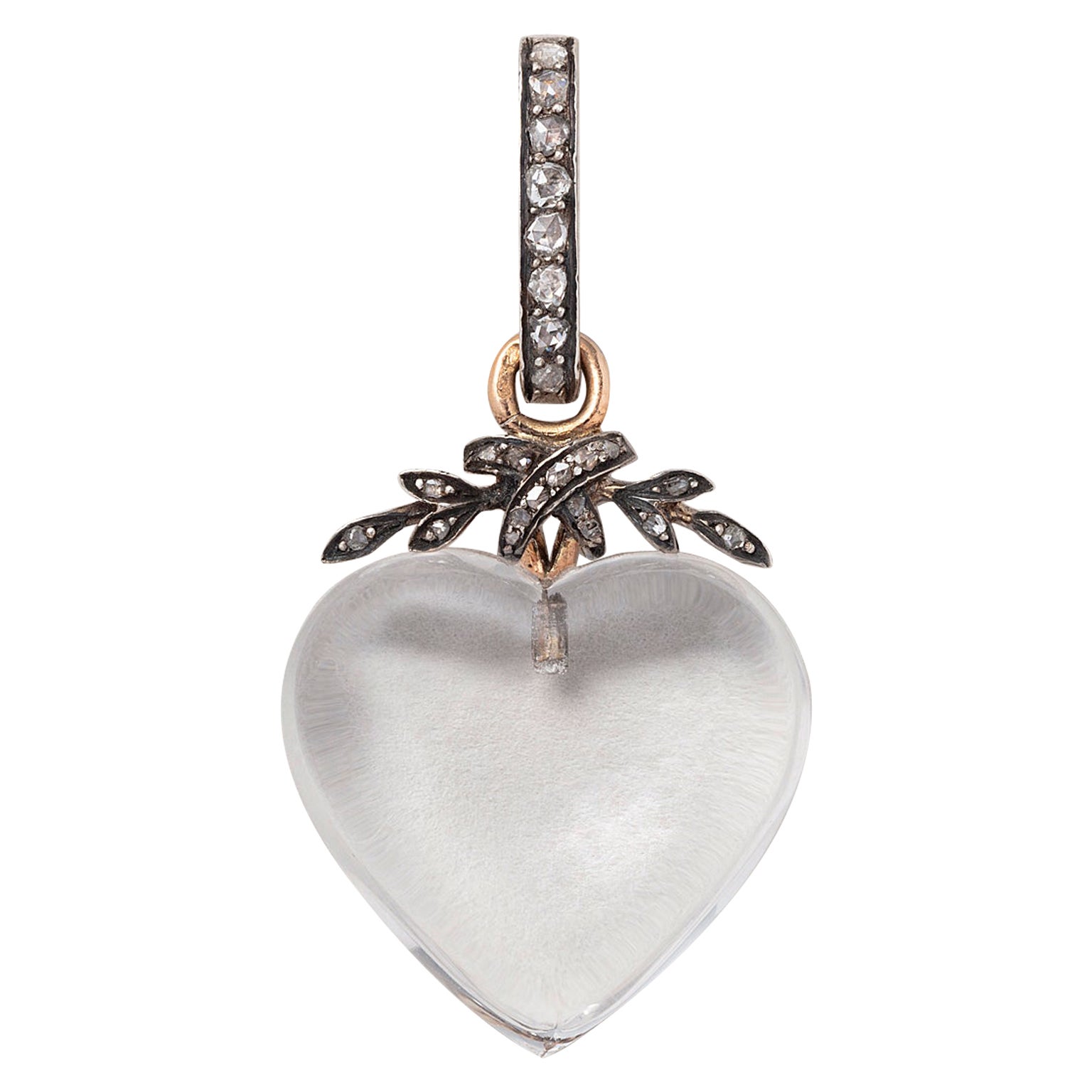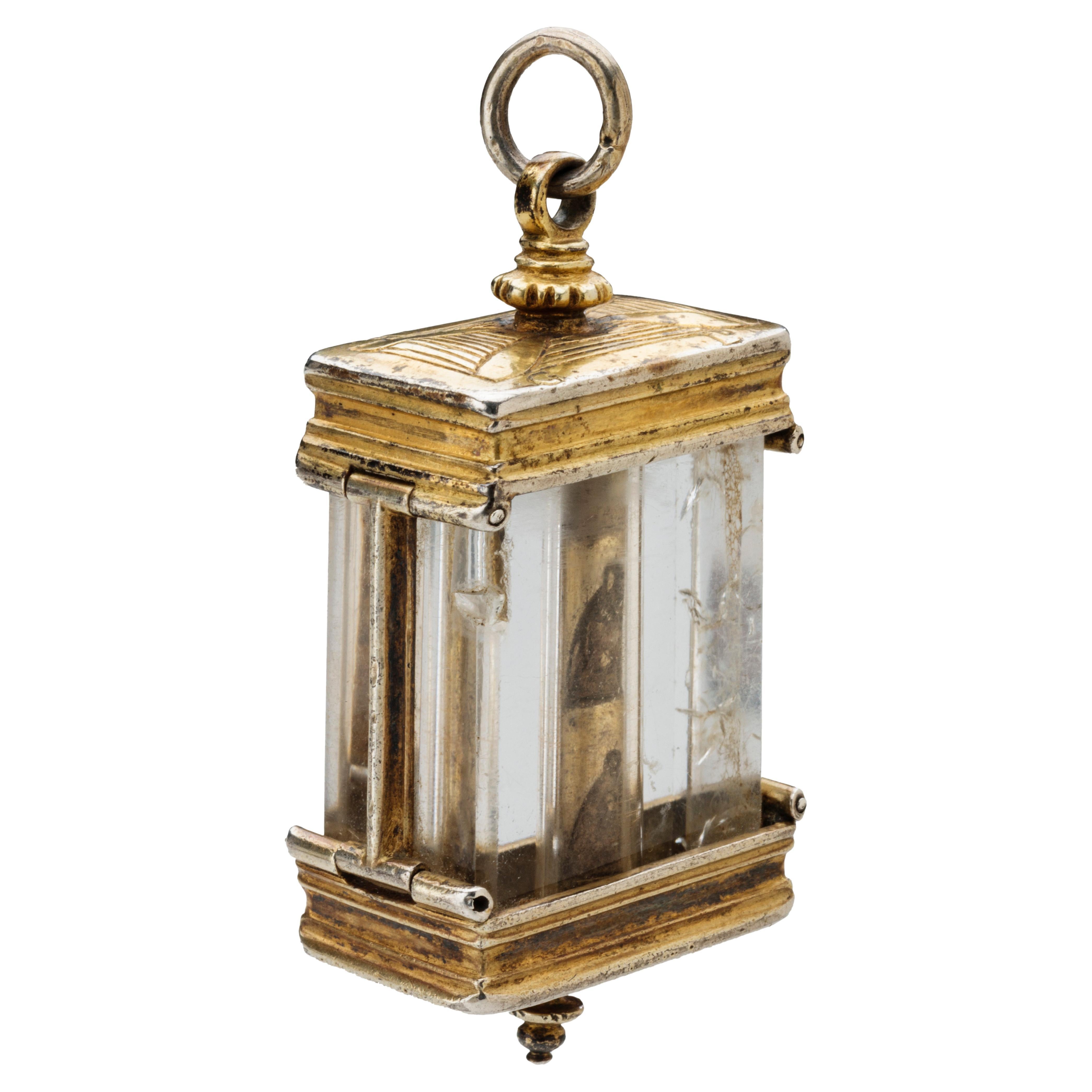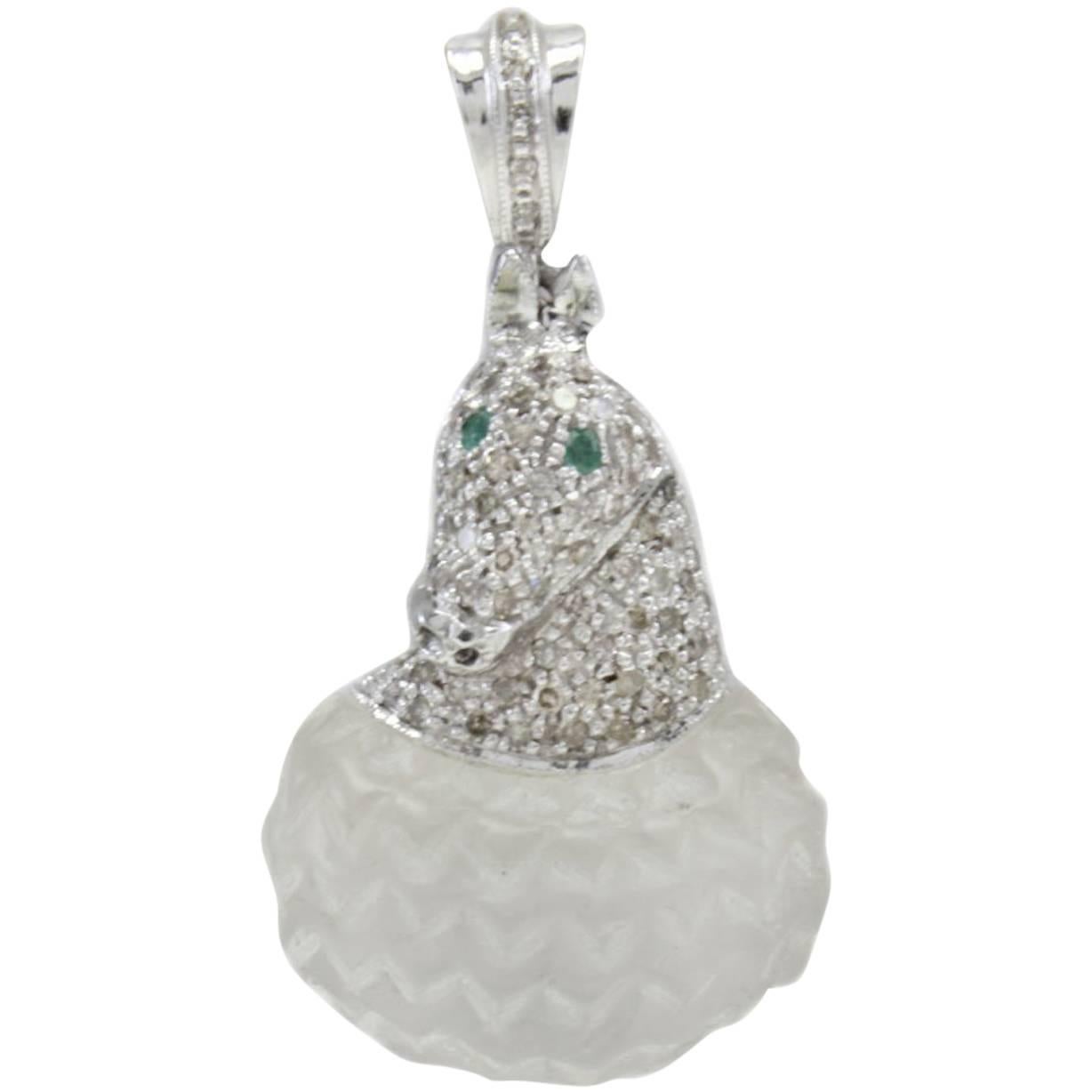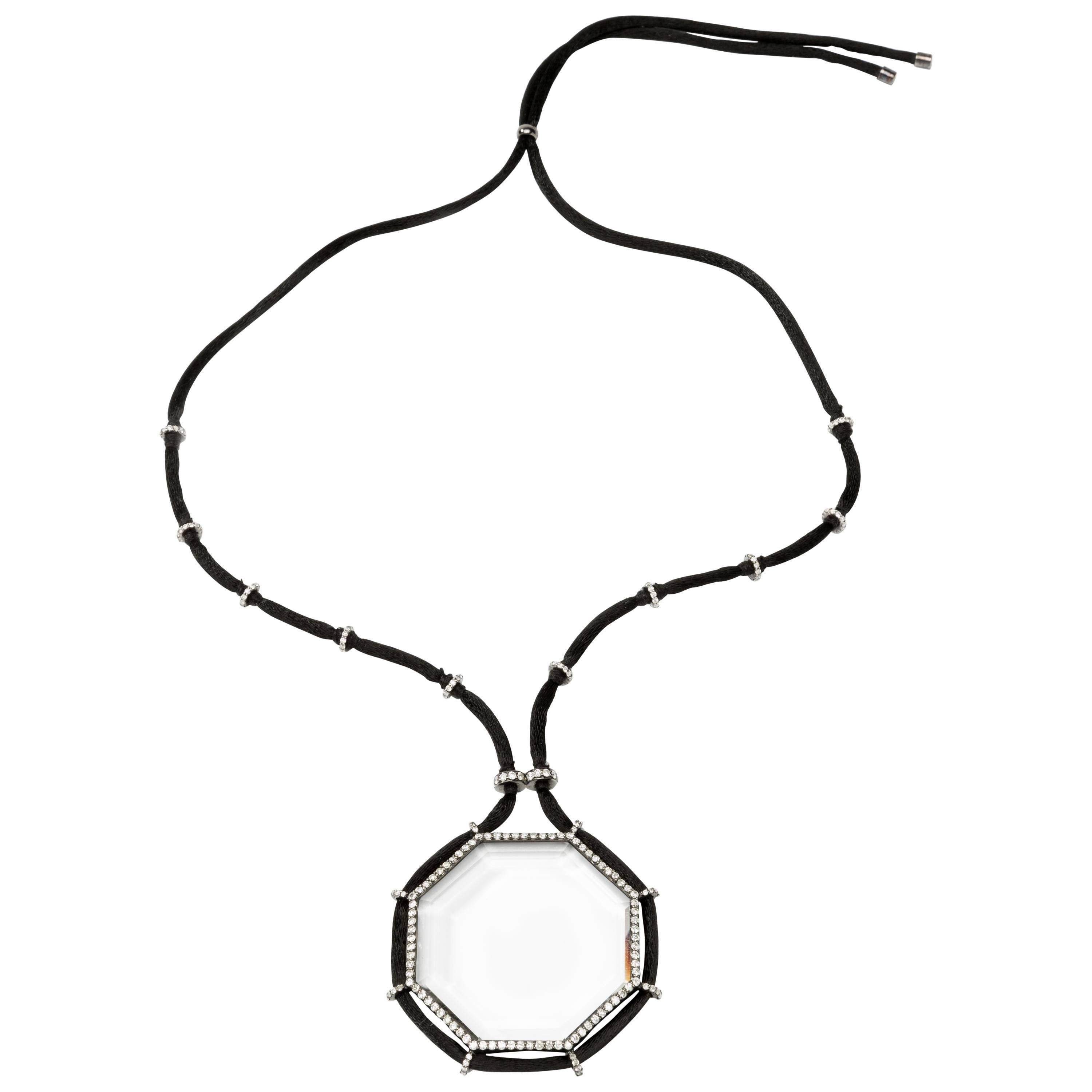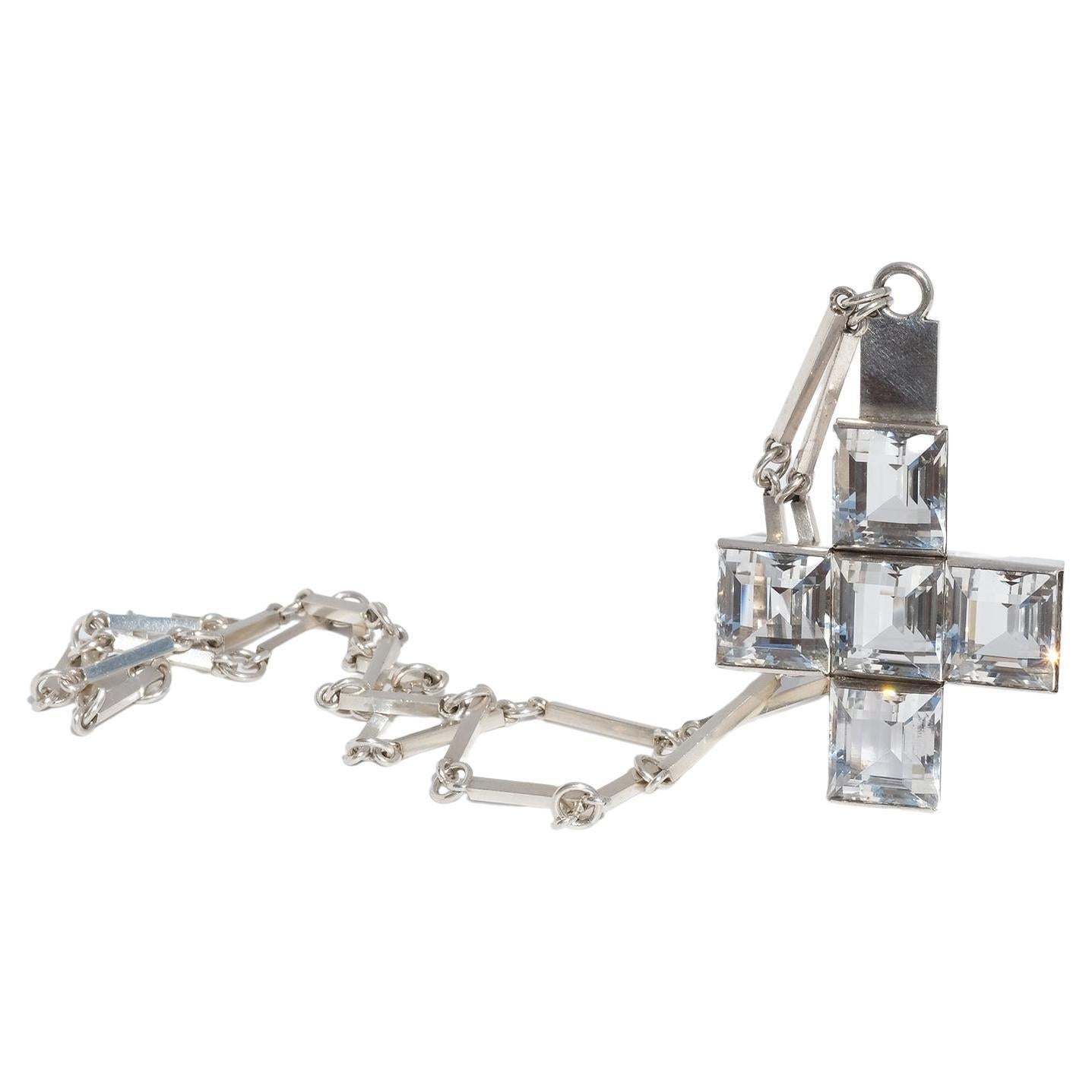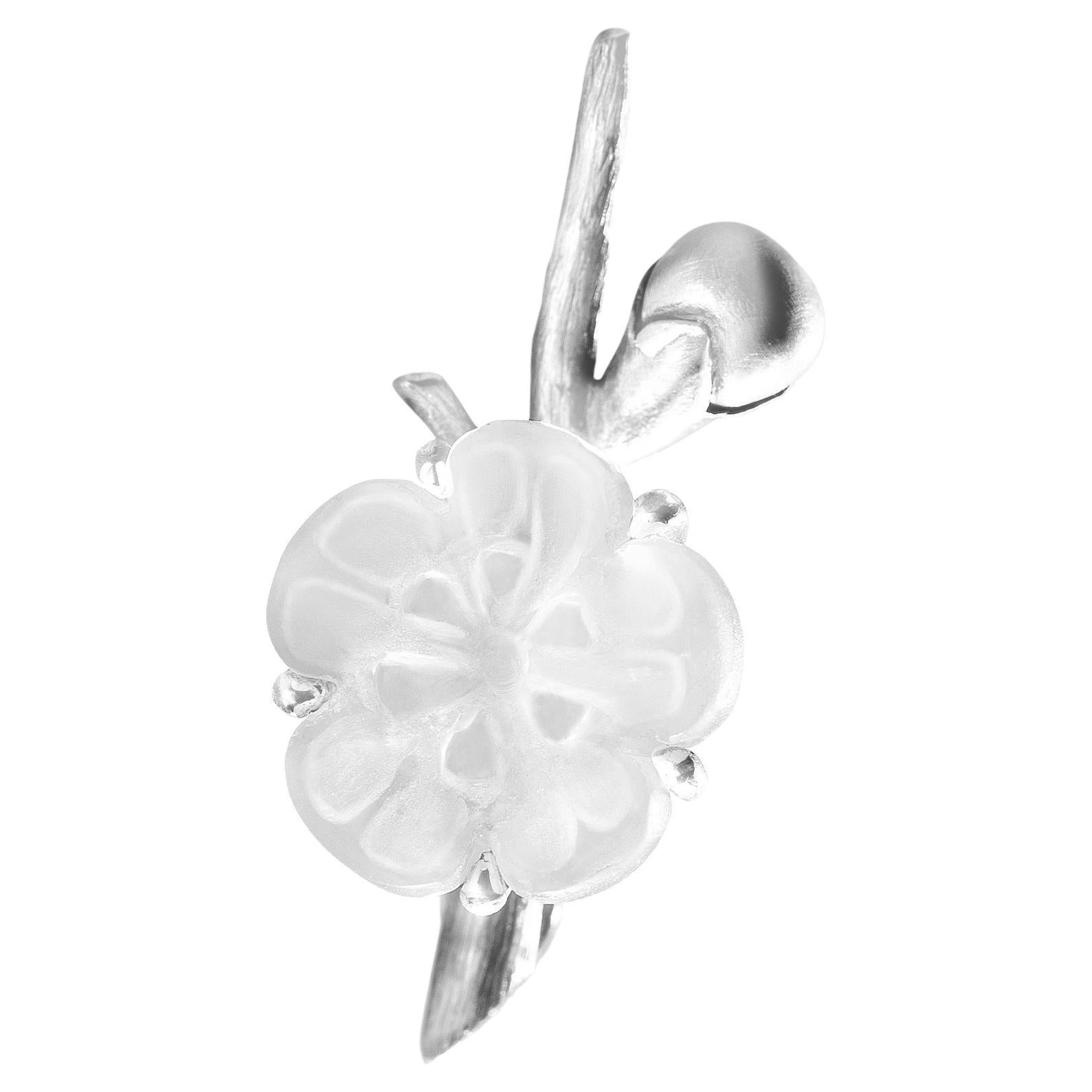Items Similar to Antique Silver Spanish Cross Pendant with Rock Crystals
Video Loading
Want more images or videos?
Request additional images or videos from the seller
1 of 6
Antique Silver Spanish Cross Pendant with Rock Crystals
About the Item
Cross Pendant with Rock Crystals
Spain or Portugal, late 17th - early 18th century
Silver, gold, rock crystal
Weight 9.1 gr.; Dimensions 56.3 × 38.8 mm.
An elaborate and elegant cross pendant made of silver with rock crystals in closed settings. The center consists of a larger round gemstone surrounded by five irregular-shaped stones forming the cross. The openwork arms have a triangular shape and are formed of facetted rock-crystals in foliate settings. The obverse side of the cross consists of a layer of gold. An extension with two stones and an angular shaped frame is hooked into the pendant loop, probably to be worn on a velvet band. The pendant is in good, wearable condition.
After the Reformation, cross pendants were worn mainly in Catholic countries by men, women, and children. During the seventeenth century, the designs became ever more intricate, and the crosses were often embellished with gemstones, such as rock crystals in this example. These were sourced along the Alpine regions of France, Switzerland, Austria, and Southern Germany. The stones gave the appearance of diamonds.
The foliate settings are characteristic of late seventeenth- and eighteenth-century jewelry made in Spain and Portugal. During this period, silver became widely used to emphasize the whiteness of the diamonds or rock crystals and enhance the sparkle. The reverse was often gilt so that the tarnish would not transfer to clothing or the neck. This cross pendant was probably adapted in the eighteenth century with the additional hook so that it could be worn suspended from a black velvet band, like a choker high on the neck.
Provenance: Private Collection, Austria
- Metal:
- Stone:
- Stone Cut:
- Weight:9.1 g
- Dimensions:Width: 1.53 in (38.8 mm)Length: 2.22 in (56.3 mm)
- Period:Late 17th Century
- Date of Manufacture:c. late 17th- early 18th century
- Condition:Wear consistent with age and use.
- Seller Location:Chicago, IL
- Reference Number:
About the Seller
5.0
Vetted Seller
These experienced sellers undergo a comprehensive evaluation by our team of in-house experts.
Established in 1991
1stDibs seller since 2021
5 sales on 1stDibs
Typical response time: 13 hours
- ShippingRetrieving quote...Ships From: Chicago, IL
- Return PolicyA return for this item may be initiated within 3 days of delivery.
More From This SellerView All
- Antique Architectural Rock Crystal PendantLocated in Chicago, ILROCK CRYSTAL PENDANT WITH COLUMN France or Italy, 16th century Fire-gilded silver, rock crystal, verre églomisé Weight 96 grams; dimensions 75 × 35 × 21 mm (with loop) Architec...Category
Antique 16th Century Medieval Pendant Necklaces
MaterialsCrystal, Rock Crystal, Gilt Metal
- Antique Spanish Jet Amulet Pendant with FigaLocated in Chicago, ILAMULET PENDANT WITH FIGA Spain, c. 1620–1630 Jet, silver, and enamel Weight 60.7 grams; dimensions 85 × 49 × 18 mm Large pendant in the shape of a hand carved from jet with a clinched fist in the figa (Spanish higa) gesture. In the palm of the hand is a heart carved in relief and on the back a six-ray star in a circle. The silver mount covers the wrist like a cuff and is decorated with a frilled border, and on the front with collet-set bosses with silver C-scrolls against blue enamel; on the back is a roundel in relief with floral motif. Domed base for the pendant loop in pea-pod form. The figa (also fica or higa) represents an age-old symbol of protection against the evil eye and other demonic threats. Its origins were pagan and buried deep in antiquity. Roman examples, such as one found recently in an archeological excavation in London, also make it clear that the protective qualities are based in a sexual symbolism–particularly the power of the phallus. The Roman bone figa/phallus in effect represents the phallus twice; that is, the gesture made by the figa hand is generally explained as fingers representing the female genitalia (vulva) penetrated by the phallus of the thumb. But other interpretations are less specific, including explanations that the left hand is the feminine principle, and the right hand is the masculine. In Spain, jet figa are common; we see one in the portrait of Anne of Austria the infanta (p. 75). That is not to say that the objects are not sumptuous or treasured. Jet was a very valuable material, and in many examples like this one, the figa is embellished with beautiful enameling or is even gem-studded. Comparable objects occur in equally sumptuous materials such as rock crystal. The enameled setting allows a dating of these objects that otherwise might prove difficult, given that the production of such objects in Spain is so consistent over centuries. Indeed, there is another, even more elaborately carved example in this collection, attached to the “magic belt” (no. 9). That example may belong to an earlier group. That figa includes deeply excavated carving, including on the upper surface, an M-shaped design that Walter Leo Hildburgh links to the heart shape (as it occurs more explicitly on this example). Hildburgh argues that its presence is especially common on these objects and that it originally represented the Sacred Heart of Mary...Category
Antique Early 17th Century Spanish Pendant Necklaces
MaterialsSilver
- Antique Eastern European Silver Cross PendantLocated in Chicago, ILRELIQUARY CROSS PENDANT Balkans (probably Bulgaria), 18th-19th century Gilded silver, glass pastes Weight 40.7 grams; dimensions 74 × 15 × 10 mm Double-sided pendant made of gilded silver filigree in the shape of a Greek cross, with pendant loop. The front and side panels composed of intricate filigree scrolls, globules, and a central rosette. Interspersed are crimped collet settings with corded wire base and red, blue, and green glass-paste gem...Category
Antique 18th Century More Jewelry
MaterialsSilver, Gilt Metal
- 19th century Water Squirt Ring in Silver and Gold with Rock CrystalLocated in Chicago, ILSquirt Ring West European, 1800-1900 Silver, gold, rock crystal Weight 9.4 gr.; circumference 60.38 mm.; cylinder length 41.2 mm US size 9 ¼ ; UK size S ¼ Fascinating nineteenth century party piece, incorporating an elegant and sparkling ring Description: Squirt ring made of a hollow silver cylinder with four ornamental bands and a cap with plunger. This holds the liquid, and when the plunger is pulled out and pushed back in the squirt mechanism is triggered. At the other end is a hollow ring through which the liquid flows and then squirts out of a small hole on the band next to the gemstone. The gold ring, angled to the cylinder, has a tubular hoop and a gold round-shaped cup bezel with a silver-set, facetted rock crystal gemstone. The ring is fully functionable. The cylinder lies concealed in the palm of the hand. Punched on the cylinder is a swan, the French guarantee mark for the fineness of silver on items of unknown origin (in use from 1893-1970). Along the gold hoop of the ring are four indistinct hallmarks: a helmeted head (?), two rectangular punch marks, one with lower case ‘g’ in the corner, and traces of two illegible punches. Provenance: Yves Brasseur (26 February—11 August 2005), Ghent, Belgium, a collector of rings who was a Belgian fencer of Olympic stature, having competed in this sport in the Olympics in the 1960s. Literature: The earliest account of a squirt ring dates to about 1770 with the description of a diplomatic incident at the Court of Frederick the Great. The French ambassador M. de Guines belonged to the diplomatic corps in Berlin, the capital of the Prussian Empire. His pompous behavior was widely mocked. Prince Dolgorouki, the Russian ambassador was invited to a gala dinner as a guest of honor with his newly wed bride. She was seated next to the French ambassador whom she squirted with water from a mechanism concealed in the palm of her hand, when he was admiring her jewel. He vowed he would throw a glass of water at her if she continued. The ambassador’s wife ignored his warning, and he in fact put his threat into effect. The guests at the dinner were obliged to keep a discreet silence surrounding this embarrassing occurrence. The fashion for such squirt rings appears to have continued into the nineteenth century, although few examples are known. The designs and materials vary: bronze ring with mask of Silenus in the Victoria and Albert Museum. Silenus, the god of wine-making and drunkenness, appears again on a squirt ring in form of a garnet cameo...Category
Antique 19th Century European Solitaire Rings
MaterialsRock Crystal, Quartz, Gold, Silver
- Antique Gold Pendant with Diamonds and PearlsLocated in Chicago, ILPendant with Virgin Mary as Queen of Heaven Western Europe, Southern Germany (?), Italy (?), c. 1550-1560 Gold, enamel, diamonds, and pearls Weight 13.2 gr; Length 36.9 x 31.2 mm (incl. pearls) This sumptuous image exudes regal power. It portrays the Virgin Mary as Queen of Heaven wearing a dress and crown studded with seven large diamonds and set against a translucent, rich blue celestial background. Far removed from the tender, humble Virgin seen in German and Netherlandish artworks of the period, she is a majestic ruler, mouth sternly set, head tilted upward, and face in full profile. The oval pendant cast in high gold relief with a central medallion, the single figure filling the space, echoes jewelry portraits of the aristocracy during the Renaissance, which similarly offset the ruler’s image against a blue field composed of enamel or lapis lazuli, symbolic of divine power Only the rays of the shining gold halo that emerge behind the Virgin’s head and her long flowing hair (instead of neatly coiffed) distinguish her from female ruler portraits of the period. Three studded pearls, forming an axis, also recall pendants of European rulers. Wealth, royal status, and divine power come together in this opulent pendant. Portraits of the period show similar small oval pendants worn by women in the square of the garment or by men nestled inside multiple chains below the base of the neck. PROVENANCE European Private Collection LITERATURE Compare images from ancient Rome, for example a sardonyx cameo with female head (Kugel 2000, no. 18; Milan, c. 1550), and a pendant with gold, pearls, and enamel in the Staatliche Museum Kassel (Schmidberger/Richter 2001, no. 43; France, c. 1555-1560). For ruler pendants with blue backgrounds see a pendant of King Frances I...Category
Antique 16th Century Pendant Necklaces
MaterialsDiamond, Pearl, Gold
- Antique Spanish Hat Badge Pendant Carved in JetLocated in Chicago, ILBADGE WITH ST. JAMES THE GREAT Northern Spain, 16th century Silver, jet Weight 18.2 grams; dimensions 44 × 43 × 12 mm Round pendant with high-relief image of St. James the Great of Santiago de Compostela carved in jet. The saint is flanked by two pilgrims (their heads defaced); each holds a staff and rosary in his hand. Silver mount with plain flat backplate, corded wire surround and toothed edge as setting. Four pendant loops for sewing onto a hat or cloak. According to the Roman naturalist Pliny, jet, the material of which this pin was made, prevented snakebite and was “thrown up by the sea.” The first quality would certainly have been reassuring for a pilgrim who owned this object and who had to make long journeys over unfamiliar terrain. The second quality made jet an especially fitting material to honor St. James, given that his body arrived in Spain mysteriously, carried there “by the sea” from the Holy Land. Santiago de Compostela was a major center for jet carving from the late Middle Ages, and highly polished jet was a desirable and common material for pilgrimage souvenirs. One even finds scallop shells, the pilgrim’s badge...Category
Antique 16th Century Spanish More Objets d'Art and Vertu
MaterialsSilver
You May Also Like
- An Antique Gold and Silver Heart Pendant with Rock Crystal and diamondsDiamondLocated in Amsterdam, NLA heart-shaped rock crystal pendant with an 18-carat gold and silver laurel motif along the top of the heart and a large bail all set with rose cut diamonds (app. 0.31 carat). France...Category
Antique 1880s French Victorian Pendant Necklaces
MaterialsCrystal, Rock Crystal, Gold, 18k Gold, Silver
- Gold Silver Diamond Emerald Rock Crystal PendantLocated in Marcianise, Marcianise (CE)SHIPPING POLICY: No additional costs will be added to this order. Shipping costs will be totally covered by the seller (customs duties included). PS: THIS POLICY IS NOT APPLICABLE ...Category
Late 20th Century Italian Retro Pendant Necklaces
MaterialsDiamond, Emerald, Rock Crystal, 14k Gold, White Gold, Silver
- 1920s Rock Crystal Diamonds Silver Pendant NecklaceLocated in Berlin, DEAn exceptional piece of jewelry. Rock crystal plaque, octagonal shaped surrounded by brilliant-cut diamonds. On a black cord, accented by 12 rings of brilliant...Category
Early 20th Century Pendant Necklaces
MaterialsDiamond, Rock Crystal, Silver
- Silver Necklace with Rock Crystal Cross, Made by Wiwen Nilsson in 1939, SwedenBy Wiwen NilssonLocated in Stockholm, SEThis sterling silver necklace shows upon typical Wiwen Nilsson characteristics; the pendant which is shaped as a Greek cross with square rock crystals, and the ring and bar chain. ...Category
Vintage 1930s Swedish Chain Necklaces
MaterialsRock Crystal, Silver
- Sakura Contemporary Pendant by the Artist in Silver with Rock Crystal FlowerBy Polya Medvedeva JewelleryLocated in Berlin, DEThis contemporary pendant necklace in silver belongs to the Sakura collection, which was featured in Vogue UA magazine. The item features a contemporary design and adds a romantic to...Category
21st Century and Contemporary German Artist Pendant Necklaces
MaterialsQuartz, Crystal, Rock Crystal, Silver, Sterling Silver
- Silver Necklace with a Rock Crystal Pendant by Swedish Atelje Stigbert Year 1967Located in Stockholm, SEThis silver and rock crystal necklace shows upon typical Art Deco style characteristics, such as the ring and bar chain, the pendant with its straight geometric shapes, its shiny sur...Category
Vintage 1960s Swedish Pendant Necklaces
MaterialsRock Crystal, Silver
Recently Viewed
View AllMore Ways To Browse
Austrian Crystal Jewelry
18th C Cross
Antique Diamond Cross Pendant
Antique Clothing Hook
Antique White Gold Cross
Choker Enhancement
Antique Womens Clothing
Antique Diamond Neck
Gold Womens Crosses
17th C Silver
Chokers With Enhancers
Crystal Cross Pendant
Large Diamond Men
Mens Large Diamond
Antique Diamond Gold Cross Pendant
Austrian Silver Pendant
Antique Silver Cross Pendant
Antique Cross Silver Gold
